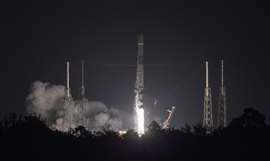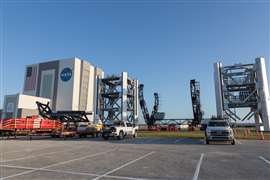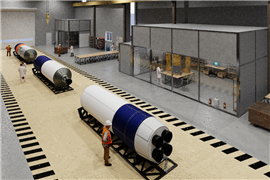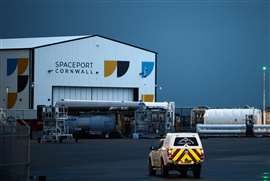Out of this world: Construction demand from space sector is skyrocketing
24 September 2024
With space enabled technology advancing rapidly, the space economy is expected to reach US$1.8 trillion by 2035, opening up a constellation of construction opportunities on Earth. Lucy Barnard reports.
Five hundred kilometers above Earth’s surface, two identical metal boxes roughly the size of a pencil case, are hard at work collecting data and beaming it back to the ground on behalf of US-based engineering company Jacobs.
The satellites, known collectively as Mango Two, are performing Radio Frequency survey missions on behalf of the engineering company which launched them via a SpaceX Falcon 9 mission in November 2023.
Mango Two (a and b) are Jacob’s second satellite launch, following the company’s Mango One satellite which the company employed between 2020 and 2021.
 A Falcon 9 SpaceX rocket deploying Starlink satellites lifts off. Photo: Reuters
A Falcon 9 SpaceX rocket deploying Starlink satellites lifts off. Photo: Reuters
“We’re shaping the future of space solutions, empowering decision-makers to stay ahead of evolving threats,” says Chris Carroll, senior director of advanced programs for Jacobs’ Rapid Solutions group.
Moreover, for Jacobs, which is NASA’s largest service provider and is involved in both the Mars Perseverance Rover and the Artemis deep space human exploration programmes, the space industry is an increasingly growing part of the company’s terrestrial business too.
In the unlikely location of the A’Mhòine peninsula in the remote north of Scotland, the company is busy building a launchpad capable of sending twelve satellite-carrying rockets a year into space.
In October 2022, Jacobs was one of four main participants in a £40.4 million (US$53.3 million) series C fundraising for UK-based spaceflight company Orbex which is planning to use the 10-acre Scottish site to launch its 19-metre-long, two-stage Prime rocket to transport small satellites weighing 180 kilograms into low earth orbit.
As a result of that deal, Jacobs is acting as main contractor for the Scottish spaceport, a role that includes design, procurement, management of the local supply chain as well as providing operations support and engineering services. Work on the project started in 2023 and is expected to be completed by the end of the year.
Across the Atlantic in Houston, Texas, a location far more frequently associated with space travel, Jacobs has been working, both on the design of an urban commercial spaceport and on a 100,000-square-foot assembly, integration and testing facility where space company Axiom Technology is putting together what it hopes will be the world’s first commercial international space station.
Space economy to reach US$1.8 trillion by 2030
And, as the commercial space sector continues to take off, experts say the number of opportunities for a whole range of industries to benefit - including construction - will skyrocket.
“The space sector is at an inflection point similar to what commercial air travel experienced after World War II and the internet saw in the 1990s,” says Ryan Brukardt, a senior partner at McKinsey and a former space and missile operations officer in the US Air Force.
“We assert that space is a timely topic for all [business] leaders,” Brukardt continues. “Massive technological innovation is creating the opportunity for more capabilities to be deployed above Earth for the benefit of those on Earth. This creates an imperative for executives: if space isn’t part of your strategy, it needs to be.”
 A barge dock for SpaceX tower segment 5 & 6 with chopsticks and clamps are for shipping to Starbase Texas Boca Chica Texas from Kennedy SpaceCenter, Florida. Photo: Reuters
A barge dock for SpaceX tower segment 5 & 6 with chopsticks and clamps are for shipping to Starbase Texas Boca Chica Texas from Kennedy SpaceCenter, Florida. Photo: Reuters
In April, the World Economic Forum predicted that the space economy is expected to reach US$1.8 trillion by 2035 as space enabled technologies advance, opening up commercial opportunities for industries on earth as well as helping to tackle some of our planet’s greatest challenges.
Certainly, the space race today has moved on from the days of the Apollo missions in the 1960s and 1970s when the governments of the US and the Soviet Union were the only big players. Today more than 70 countries have their own space programmes and many of the missions taking place are being led by companies rather than governments.
Recently a series of milestone missions have grabbed the headlines, dominated by billionaire Elon Musk including becoming the first privately developed crewed mission to orbit and visit the International Space Station, and the first orbital spaceflight with only private citizens aboard. Others are hot on SpaceX’s heels including Richard Branson’s Virgin Galactic and Jeff Bezos’ Blue Origin.
Part of the reason for this is that improving technology is making it cheaper to fly into space in the first place and – perhaps more lucratively – to launch satellites into space.
McKinsey estimates that launch costs have fallen 95% since the Moon Landings and that there is another massive reduction expected in the coming years due to increased volumes and reuse.
Unlike heavy commercial communications satellites which have been used since the 1960s by TV channels and the armed forces and which cost hundreds of millions of dollars to build and launch, modern satellites can weigh just 25-50 kilograms, cost between US$100,000 and US$1 million to launch and can be mass produced in factories.
Small satellites fuel space boom
Tech firms, such as SpaceX, Amazon and Shanghai Spacecom Satellite Technology, are using these ‘nanosats’, which fly at a relatively low orbit (between 160-1,000 kilometres above the Earth) to attempt to provide connectivity to people in rural areas who currently have no access to the internet as well as to collect data in order to offer a whole range of services including monitoring construction sites, better understanding the effects of climate change, predicting yield improvement opportunities for farmers, identifying times when wind farms will be most productive and assessing risks and damages for insurance companies.
With an estimated 25,000 satellites expected to be launched over the next decade, these companies are looking to build new launch facilities where spacecraft are assembled and launched as well as a growing number of advanced manufacturing facilities where satellites are made and tested.
According to space data company Brycetech, in 2024, there are nearly fifty orbital and suborbital launch sites around the world in operation while there are more than thirty more currently proposed or under construction.
The USA is the country with the most spaceports, being home to more than twenty with another six proposed. It is followed by China which is currently home to eight spaceports and is planning another four domestically, as well as a spaceport in Djibouti. Australia is also investing heavily in the sector. It has recently completed two orbital launch sites and has plans for another four. And the UK completed its first spaceport in Cornwall in 2022 and is planning a further six around the British Isles.
 Interior of the Horizontal Integration Facility at Arnhem Space Centre, Australia. Photo: Arnhem Space Centre
Interior of the Horizontal Integration Facility at Arnhem Space Centre, Australia. Photo: Arnhem Space Centre
One of the most prominent is SpaceX’s 350-acre Starbase industrial complex and spaceport at Boca Chica, near Brownsville in Texas which broke ground in 2014 and hosted its first full scale launch in April 2023. The facility includes both a spaceport and a production facility where all Starship and Super Heavy prototypes are built and assembled. The company is currently working on a second launch pad at the facility as well as a shopping centre and office complex. Construction firms involved in the project included Texas-based Osburn Contractors, North Carolina-based Martin Marietta Materials, Texas-based materials supplier CMC Construction Services and Texas-based excavating business Hydroz Energy Services.
In China too, spaceport construction is ramping up. In January 2024, HICAL, a joint venture of the Hainan government and three state-owned conglomerates, announced it had completed construction of the first launch pad at its Wengchang Commercial Space Launch Site. Construction of a second launch pad is expected to be completed this year and a groundbreaking for a third pad took place in June 2023.
Spaceport construction is ramping up
Further East, Ningbo International Commercial Space Launch Centre reported that it had committed 20 billion yuan (US$3 billion) to build a spaceport capable of launching 100 missions a year. The spaceport will cover 67 square kilometres, comprising 35 square kilometres for launch sites and 32 square kilometres for support facilities. It said that the construction contract for the launch complex had been won by a Zhejiang province engineering company.
In Australia’s Northern Territory, the Arnhem Space Centre, near Nhulunbury, on the lands of the Gumatji people started construction at the end of 2021. By June 2022 the base became the site of the first commercial space launch in Australian history when NASA launched a scientific research rocket there. The 60-hectare site, which is leased from the Gumatj Corporation on a 40 year lease by Australian space startup Equatorial Launch Australia is located 12 degrees south of the equator which makes it particularly suitable as a base for scientific research missions. Local Gumatji firms and workers were involved in the construction of the spaceport, which the tribes hope will provide high income jobs for First Nation people while UK-based Aggreko was contracted to supply temporary power, both for the site and to launch the rocket.
 Spaceport Cornwall. Photo: Reuters
Spaceport Cornwall. Photo: Reuters
In the UK, Spaceport Cornwall made headlines in 2023 when it facilitated the country’s first ever domestic space launch when a modified Virgin Orbit 747 plane unsuccessfully attempted to send nine satellites into orbit. The facility, located on the existing Newquay Airport was completed in 2022, by two main contractors – Kier, which led the general construction and specialist firm Bassaire which headed up the cleanroom elements. Work included building a space systems integration facility – a clinical grade aircraft hangar where rockets are assembled and a new multi-purpose operations facility comprising offices and laboratories.
Away from the launch sites too, demand for the advanced manufacturing facilities required to produce satellites is also increasing.
SpaceX, the world’s largest producer of satellites, has been making its satellites in a factory at Redmond, Washington but last year completed work on a 500,000 square-foot production facility in Bastrop, Texas.
Meanwhile, in April 2024, Amazon officially opened its new 172,000 square foot Project Kuiper satellite manufacturing hub in Kirkland, Washington.
Growth of megafactories to manufacture satellites
“The facility includes a wide variety of custom equipment required to manufacture and test space-grade hardware, including liquid nitrogen tanks that help quickly cool test cambers to temperatures found in space and robotic arms that help test and calibrate the advanced communications payloads onboard each spacecraft,” Amazon said in a recent company update. “Project Kuiper considers most of the facility a clean space that requires special attire to protect the sensitive electronics from electrostatic discharge.”
And in Europe, Belgian specialist Aerospacelab is building Megafactory, a 25,000 square meter satellite manufacturing facility in Charleroi, which it says will be the third largest satellite factory in the world. The facility comprises two buildings, a 7,000 square meter of production area and 4,000 square meters clean room, connected by a pedestrian bridge sixteen meters above the ground. The factory is scheduled to begin manufacturing in 2026 and could produce up to 500 satellites a year.
CONECTAR-SE COM A EQUIPE





